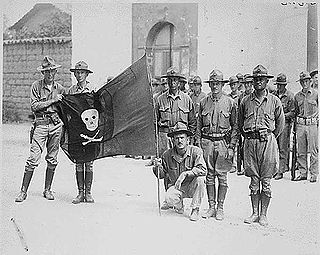 W
WThe Banana Wars were a series of conflicts that consisted of military occupation, police action, and intervention by the United States in Central America and the Caribbean between the end of the Spanish–American War in 1898 to the inception of the Good Neighbor Policy in 1934. The military interventions were primarily carried out by the United States Marine Corps, who also developed a manual, the Small Wars Manual (1921) based on their experiences. On occasion, the United States Navy provided gunfire support and troops from the United States Army were also deployed.
 W
WIn political science, the term banana republic describes a politically unstable country with an economy dependent upon the exportation of a limited-resource product, such as bananas or minerals. In 1904, the American author O. Henry coined the term to describe Honduras and neighbouring countries under economic exploitation by U.S. corporations, such as the United Fruit Company. Typically, a banana republic has a society of extremely stratified social classes, usually a large impoverished working class and a ruling class plutocracy, composed of the business, political, and military elites of that society. The ruling class controls the primary sector of the economy by way of the exploitation of labor; thus, the term banana republic is a pejorative descriptor for a servile oligarchy that abets and supports, for kickbacks, the exploitation of large-scale plantation agriculture, especially banana cultivation.
 W
WThe ABC countries, or ABC powers, are the South American countries of Argentina, Brazil and Chile, seen as the three most powerful, most influential and wealthiest countries in South America. The term was mostly used in the first half of the 20th century, when they worked together to develop common interests and a coordinated approach to issues in the region with relatively little influence from outside powers, in contrast with the Cold War governments.
 W
WThe Battle of Achuapa, or the Achuapa massacre, took place on December 31, 1930 during the American occupation of Nicaragua of 1926–1933.
 W
WThe Battle of Agua Carta, or the Battle of Lindo Lugar, was an engagement between the National Guard of Nicaragua and the rebels of Augusto César Sandino in 1932. It was fought near Mount Kilambe at the Agua Carta, a river in Sandino territory, as part of the American occupation of Nicaragua and a long lasting civil war.
 W
WThe United States occupation of Haiti began on July 28, 1915, when 330 United States Marines landed at Port-au-Prince, Haiti, on the authority of President of the United States Woodrow Wilson to establish control of Haiti's political and financial interests. The invasion and subsequent occupation was promoted by growing American business interests in Haiti. The July intervention took place following years of socioeconomic instability within Haiti that culminated with the assassination of President of Haiti Vilbrun Guillaume Sam by insurgents angered by his ordered executions of elite opposition. The occupation ended on August 1, 1934, after President Franklin D. Roosevelt reaffirmed an August 1933 disengagement agreement. The last contingent of marines departed on August 15, 1934, after a formal transfer of authority to the American-created Gendarmerie of Haiti.
 W
WThe United States occupation of Nicaragua from 1912 to 1933 was part of the Banana Wars, when the US military invaded various Latin American countries from 1898 to 1934. The formal occupation began in 1912, even though there were various other assaults by the U.S. in Nicaragua throughout this period. American military interventions in Nicaragua were designed to stop any other nation except the United States of America from building a Nicaraguan Canal.
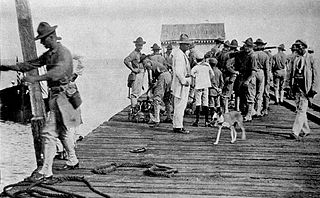 W
WThe first United States occupation of the Dominican Republic lasted from 1916 to 1924. It was one of the many interventions in Latin America undertaken by the military forces of the United States in the 20th century. On the 13 May 1916, Rear Admiral William B. Caperton forced the Dominican Republic's Secretary of War Desiderio Arias, who had seized power from Juan Isidro Jimenes Pereyra, to leave Santo Domingo by threatening the city with naval bombardment. The Marines landed three days later and established effective control of the country within two months.
 W
WBig stick ideology, big stick diplomacy, or big stick policy refers to President Theodore Roosevelt’s foreign policy: "speak softly and carry a big stick; you will go far." Roosevelt described his style of foreign policy as "the exercise of intelligent forethought and of decisive action sufficiently far in advance of any likely crisis." As practiced by Roosevelt, big stick diplomacy had five components. First it was essential to possess serious military capability that would force the adversary to pay close attention. At the time that meant a world-class navy. Roosevelt never had a large army at his disposal. The other qualities were to act justly toward other nations, never to bluff, to strike only when prepared to strike hard, and the willingness to allow the adversary to save face in defeat.
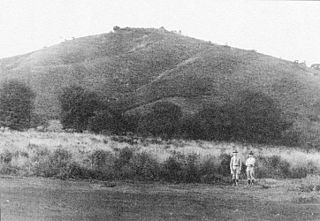 W
WThe Battle of Coyotepe Hill was a significant engagement during the United States occupation of Nicaragua from August through November 1912 during the insurrection staged by Minister of War General Luis Mena against the government of President Adolfo Díaz.
 W
WThe Battle of El Bramadero, or the Battle of Bromaderos, took place between the 27 and 28 February 1928 during the American occupation of Nicaragua of 1926–1933 and the Sandino Rebellion. The battle began on the twenty-seventh when a convoy of thirty-six Marines, one American naval pharmacist's mate, twenty Nicaraguan "muleros," two Nicaraguan "'Jefe' muleros," and 99 mules led by First Lieutenant Edward F. O'Day moving along the Yalí–Condega trail was ambushed by a force of Sandinista rebels led by Miguel Angel Ortez.
 W
WThe Battle of El Sauce, or the Battle of Punta de Rieles or Punta Rieles, took place on the 26 December 1932 during the American occupation of Nicaragua of 1926–1933. It was the last major battle of the Sandino Rebellion of 1927–1933. The incident has its origins in Nicaraguan President José María Moncada's plan to commemorate the completion of the León-El Sauce railway on the 28 December 1932.
 W
WThe Good Neighbor policy was the foreign policy of the administration of United States President Franklin Roosevelt towards Latin America. Although the policy was implemented by the Roosevelt administration, President Woodrow Wilson had previously used the term, but subsequently went on to justify U.S. involvement in the Mexican Revolution and occupation of Haiti. Senator Henry Clay had coined the term Good Neighbor in the previous century. President Herbert Hoover turned against interventionism and developed policies that Roosevelt perfected.
 W
WGuantanamo Bay Naval Base, officially known as Naval Station Guantanamo Bay or NSGB, is a United States military base located on 45 square miles (117 km2) of land and water on the shore of Guantánamo Bay at the southeastern end of Cuba. It was first leased by the United States for use as a coaling station and naval base in 1903 and is the oldest overseas U.S. naval base. The lease was $2,000 in gold per year until 1934, when the payment was set to match the value in gold in dollars; in 1974, the yearly lease was set to $4,085.
 W
WThe Battle of Guayacanas was fought on 3 July 1916 between Dominican rebels and the United States during the United States occupation of the Dominican Republic. The Dominicans dug trenches on two hills blocking passage to Santiago and kept up single-shot fire against the automatic weapons of the Americans before the Americans drove them off. Joseph A. Glowin, a corporal, was awarded the Medal of Honor for his bravery during the action.
 W
WIn international politics, the term gunboat diplomacy refers to the pursuit of foreign policy objectives with the aid of conspicuous displays of naval power, implying or constituting a direct threat of warfare should terms not be agreeable to the superior force.
 W
WThe Hay–Bunau-Varilla Treaty was a treaty signed on November 18, 1903, by the United States and Panama, which established the Panama Canal Zone and the subsequent construction of the Panama Canal. It was named after its two primary negotiators, Philippe-Jean Bunau-Varilla, the French diplomatic representative of Panama, and United States Secretary of State John Hay.
 W
WThe Hay–Herrán Treaty was a treaty signed on January 22, 1903, between United States Secretary of State John M. Hay of the United States and Tomás Herrán of Colombia. Had it been ratified, it would have allowed the United States a renewable lease of 100 years on a six-mile-wide strip across the isthmus of Panama for $10 million and an annual payment of $250,000, both payments being in gold coin. It was ratified by the United States Senate on March 14, but it was not ratified by the Senate of Colombia, so it had no effect.
 W
WThere is a long history of attempts to build a canal across Nicaragua to connect the Atlantic Ocean with the Pacific Ocean. Construction of such a shipping route—using the San Juan River as an access route to Lake Nicaragua—was first proposed in the early colonial era. Napoleon III wrote an article about its feasibility in the middle of the 19th century. The United States abandoned plans to construct a waterway in Nicaragua in the early 20th century after it purchased the French interests in the Panama Canal. The Panama Canal was built and that is now the main connecting route across Central America.
 W
WThe Battle of La Flor was fought in May 1928 between the United States Marines, their Nicaraguan National Guardsmen allies, and a force of Sandinista rebels. It occurred at a hill north of the La Flor coffee plantation and ended with a rebel victory when the Americans and Nicaraguan National Guard troops were forced to withdraw.
 W
WThe Battle of La Paz Centro took place on May 16, 1927 during the American occupation of Nicaragua of 1926–1933. It took place after the end of Nicaraguan civil war of 1926–1927 and prior to the Sandino Rebellion of 1927–1933.
 W
WThe Second Battle of Las Cruces, or the New Year's Day Battle, was a major engagement during the American occupation of Nicaragua. It was fought on 1 January 1928, during an expedition to destroy a Sandinista fortress. A column of United States Marines and Nicaraguan National Guardsmen were attacked by a superior force of rebels entrenched on Las Cruises Hill and, after a long battle, the Americans and Nicaraguans routed the Sandinistas and captured their positions.
 W
WThe Battle of Masaya took place on 19 September 1912, during the American occupation of Nicaragua of 1912—1925 and the Nicaraguan civil war of 1912.
 W
WThe Monroe Doctrine was a United States policy that opposed European colonialism in the Americas. It argued that any intervention in the politics of the Americas by foreign powers was a potentially hostile act against the United States. It began in 1823; however, the term "Monroe Doctrine" itself was not coined until 1850.
 W
WThe Nicaraguan Canal, formally the Nicaraguan Canal and Development Project was a proposed shipping route through Nicaragua to connect the Caribbean Sea with the Pacific Ocean. Scientists were concerned about the project's environmental impact, as Lake Nicaragua is Central America's key freshwater reservoir while the project's viability was questioned by shipping experts and engineers.
 W
WThe Battle of Ocotal occurred in July 1927, during the American occupation of Nicaragua. A large force of rebels loyal to Augusto César Sandino attacked the garrison of Ocotal, which was held by a small group of US Marines and Nicaraguan National Guards. Ultimately the rebels were defeated with heavy losses, while the Americans and their Nicaraguan allies suffered very light casualties.
 W
WThe separation of Panama from Colombia was formalized on 3 November 1903, with the establishment of the Republic of Panama. From the Independence of Panama from Spain in 1821, Panama had simultaneously declared independence from Spain and joined itself to the confederation of Gran Colombia through the Independence Act of Panama. Panama was always tenuously connected to the rest of the country to the south, owing to its remoteness from the government in Bogotá and lack of a practical overland connection to the rest of Gran Colombia. In 1840–41, a short-lived independent republic was established under Tomás de Herrera. After rejoining Colombia following a 13-month independence, it remained a province which saw frequent rebellious flare-ups, notably the Panama crisis of 1885, which saw the intervention of the United States Navy, and a reaction by the Chilean Navy.
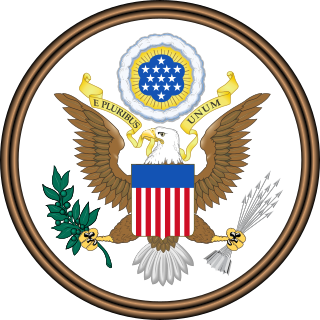 W
WOn March 2, 1901, the Platt Amendment was passed as part of the 1901 Army Appropriations Bill. It stipulated seven conditions for the withdrawal of United States troops remaining in Cuba at the end of the Spanish–American War, and an eighth condition that Cuba sign a treaty accepting these seven conditions. It defined the terms of Cuban–U.S. relations essentially to be an unequal one of U.S. dominance over Cuba.
 W
WThe Roosevelt Corollary was an addition to the Monroe Doctrine articulated by President Theodore Roosevelt in his State of the Union address in 1904 after the Venezuela Crisis of 1902–1903. The corollary states that the United States will intervene in conflicts between the European countries and Latin American countries to enforce legitimate claims of the European powers, rather than having the Europeans press their claims directly.
 W
WThe Battle of San Fernando took place on July 25, 1927 during the American occupation of Nicaragua of 1926–1933. Shortly after the Battle of Ocotal, an expedition of seventy-eight American Marines and thirty-seven Nicaraguan Provisional Guardsmen led by Major Oliver Floyd were sent hunting for rebel leader Augusto César Sandino. One of their destinations was the town of San Fernando, where Sandino had about forty men waiting for the Marines and their Nicaraguan allies. He placed a sentry outside the village to alert his men of the Marines and Provisional Guard's arrival, but the watchman abandoned his post to be alone with an Indian girl in a nearby shack. The Marines and Nicaraguan government troops marched into San Fernando at 3:00, finding it largely deserted. While galloping across the town's "open, grassy plaza" in order to question an old man, Captain Victor F. Bleasdale and Marine Private Rafael Toro received fire from the waiting Sandinistas, with Toro being mortally wounded. Eventually, the Sandinistas were driven back, leaving eleven of their dead behind. Fighting was over by 3:45. In addition to Marine and Sandinista losses, one woman was wounded in the legs by fire from an automatic weapon.
 W
WThe Battle of San Francisco de Macoris took place on 29 November 1916 during the early stages of the United States occupation of the Dominican Republic. Dominican forces in San Francisco de Macoris had refused to lay down their arms and had taken control of the local fortress. This was in direct violation of the terms imposed by the military government installed by the United States. A small squad of Marines that were close by were able to make their way inside the fortress and surprise the defenders, securing it before any organized resistance could take place.
 W
WThe Battle of Santa Clara took place on 27 July 1927, during the American occupation of Nicaragua of 1926–1933. After being ambushed by Sandinista forces at the Battle of San Fernando, Major Oliver Floyd's expedition of American Marines and Nicaraguan Provisional Guardsmen continued its advance into enemy-held territory in northern Nicaragua.
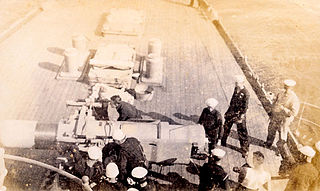 W
WThe Santo Domingo Affair, or the Santo Domingo Crisis, refers to an incident in 1904 involving the United States and Dominican militia forces in the Dominican Republic. After the death of a seaman from the USS Yankee on February 1, the U.S. military launched a punitive expedition which routed the Dominican forces.
 W
WThe Second Occupation of Cuba by United States military forces, officially the Provisional Government of Cuba, lasted from September 1906 to February 1909.
 W
WThe Small Wars Manual is a United States Marine Corps manual on tactics and strategies for engaging in certain types of military operations.
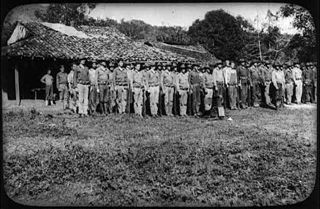 W
WThe Battle of Telpaneca was an engagement fought during the United States occupation of Nicaragua in 1927.
 W
WThe Treaty of Paris of 1898 was a treaty signed by Spain and the United States on December 10, 1898, that ended the Spanish–American War. Under it, Spain relinquished all claim of sovereignty over and title to Cuba and also ceded Puerto Rico, Guam, and the Philippines to the United States. The cession of the Philippines involved a compensation of $20 million from the United States to Spain.
 W
WThe United Fruit Company, now Chiquita Brands International, was an American corporation that traded in tropical fruit grown on Latin American plantations and sold in the United States and Europe. The company was formed in 1899, from the merger of Minor C. Keith's banana-trading concerns with Andrew W. Preston's Boston Fruit Company. It flourished in the early and mid-20th century, and it came to control vast territories and transportation networks in Central America, the Caribbean coast of Colombia and the West Indies. Though it competed with the Standard Fruit Company for dominance in the international banana trade, it maintained a virtual monopoly in certain regions, some of which came to be called banana republics, such as Costa Rica, Honduras, and Guatemala.
 W
WThe United States involvement in the Mexican Revolution was varied and seemingly contradictory, first supporting and then repudiating Mexican regimes during the period 1910–1920. For both economic and political reasons, the U.S. government generally supported those who occupied the seats of power, but could withhold official recognition. The U.S. supported the regime of Porfirio Díaz after initially withholding recognition since he came to power by coup. In 1909, Díaz and U.S. President Taft met in Ciudad Juárez, across the border from El Paso, Texas. Prior to Woodrow Wilson's inauguration on March 4, 1913, the U.S. Government focused on just warning the Mexican military that decisive action from the U.S. military would take place if lives and property of U.S. nationals living in the country were endangered. President William Howard Taft sent more troops to the US-Mexico border but did not allow them to intervene directly in the conflict, a move which Congress opposed. Twice during the Revolution, the U.S. sent troops into Mexico, to occupy Veracruz in 1914 and to northern Mexico in 1916 in a failed attempt to capture Pancho Villa. Although U.S. foreign policy toward Latin America was to assume the region was the sphere of influence of the U.S., articulated in the Monroe Doctrine and in Theodore Roosevelt's corollary to the Monroe Doctrine, which asserted the right of the U.S. to intervene militarily in the region to restore order if in the U.S. view a nation could not or would not do it itself, the U.S. role in the Mexican Revolution has been exaggerated. It did not directly intervene in the Mexican Revolution in a sustained manner.
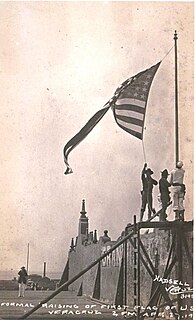 W
WThe United States occupation of Veracruz began with the Battle of Veracruz and lasted for seven months, as a response to the Tampico Affair of April 9, 1914. The incident came in the midst of poor diplomatic relations between Mexico and the United States, and was related to the ongoing Mexican Revolution.